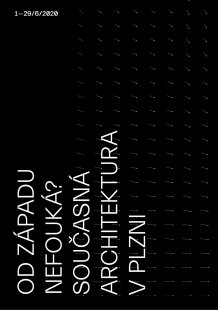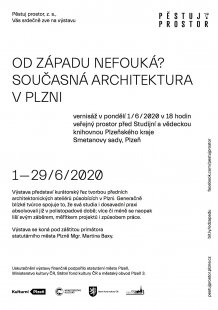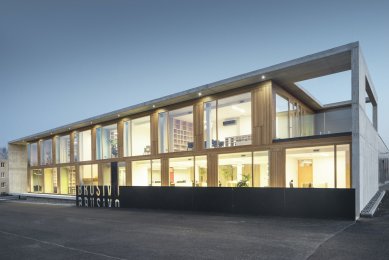
Isn't the wind blowing from the West? - contemporary architecture in Pilsen
Source
Martina Seidlerová, Pěstuj prostor z.s.
Martina Seidlerová, Pěstuj prostor z.s.
Publisher
Tisková zpráva
01.06.2020 10:00
Tisková zpráva
01.06.2020 10:00
Czech Republic
Pilsen
On Monday, June 1, 2020, at 6:00 PM, an exhibition showcasing the work of leading female architects, architects, and studios operating in Plzeň will open in the public space of Smetana Gardens in front of the Study and Scientific Library of the Plzeň Region. The association Pěstuj prostor will thus launch a long-term project "Isn't it blowing from the West? Contemporary architecture in Plzeň," which should continue in the coming years with a different exhibition in the gallery space and subsequently also with a publication. The exhibition, held under the patronage of the mayor of Plzeň, Martin Baxa, will last until June 29, 2020.
Over the past dozen years, Plzeň has written another of the post-November chapters of its architectural development. The city has been primarily shaped by transportation buildings for many future years, but other public buildings have also emerged – cultural, educational, healthcare, and more. Several public spaces have been modified. However, the largest number of buildings has been realized by private investors – residential, administrative, commercial, and sports facilities along with groups of buildings of larger and smaller scales. “The number of new buildings and reconstructed structures, which often lose their original identity, invites questions about their architectural qualities, authorship of the projects, and the overall level of the local professional scene. Is design and construction done well in Plzeň? What is the quality of public buildings here? How are local female architects and architects being implemented in Plzeň? These and other questions will be addressed in particular by further parts of the project,” states the exhibition's author from the organizing association, Petr Klíma.
The aim of the current exhibition is to highlight the existence of quality local creators, symbolically emphasize and present their selected realizations, and simultaneously appeal to the public to strive for the creation of architecture of the quality common to the presented works. “The number of selected buildings depends on the number of exhibition panels. Significantly more exemplary realizations have been created in Plzeň, yet still not enough to be adequate for a city of this size, and certainly not enough for their level to become a desired standard,” Klíma warns. Aside from basic architectural quality, the period of their creation has become a fundamental criterion for their selection, bounded by the economic crisis that hit the world in 2008 and this year, which has been marked by the coronavirus epidemic. The key common denominator of the works is the local affiliation of their authors – in all cases, these are female architects and architects working in Plzeň, but not all exhibited buildings are local. Therefore, the selection does not include quality realizations whose authors are architects from outside Plzeň.
Most of the exhibiting female architects and architects stand on their own feet or form independent studios. The selection includes family and apartment buildings, administrative buildings, various types of civic amenities, urban landscape realizations, territorial studies, as well as reconstructions, renovations, or interiors. There are also several public initiatives included. One of the panels presents a selection of the most important cultural and community interventions in public space. Another panel illustrates the regular construction production with a hundred realizations, photographed by the public alongside representatives of the association. “Its architectural quality is significantly lower than the qualities of the exhibited realizations, and it is also distinctly lower than what can be expected and needed after thirty years of free and democratic regime. However, the presented works show that the assumption and demand for raising the level of contemporary architecture in Plzeň is entirely justified,” adds Petr Klíma. The exhibition is financially supported by the statutory city of Plzeň, the Ministry of Culture of the Czech Republic, the State Cultural Fund of the Czech Republic, and the municipal district of Plzeň 3.
More information >
Over the past dozen years, Plzeň has written another of the post-November chapters of its architectural development. The city has been primarily shaped by transportation buildings for many future years, but other public buildings have also emerged – cultural, educational, healthcare, and more. Several public spaces have been modified. However, the largest number of buildings has been realized by private investors – residential, administrative, commercial, and sports facilities along with groups of buildings of larger and smaller scales. “The number of new buildings and reconstructed structures, which often lose their original identity, invites questions about their architectural qualities, authorship of the projects, and the overall level of the local professional scene. Is design and construction done well in Plzeň? What is the quality of public buildings here? How are local female architects and architects being implemented in Plzeň? These and other questions will be addressed in particular by further parts of the project,” states the exhibition's author from the organizing association, Petr Klíma.
The aim of the current exhibition is to highlight the existence of quality local creators, symbolically emphasize and present their selected realizations, and simultaneously appeal to the public to strive for the creation of architecture of the quality common to the presented works. “The number of selected buildings depends on the number of exhibition panels. Significantly more exemplary realizations have been created in Plzeň, yet still not enough to be adequate for a city of this size, and certainly not enough for their level to become a desired standard,” Klíma warns. Aside from basic architectural quality, the period of their creation has become a fundamental criterion for their selection, bounded by the economic crisis that hit the world in 2008 and this year, which has been marked by the coronavirus epidemic. The key common denominator of the works is the local affiliation of their authors – in all cases, these are female architects and architects working in Plzeň, but not all exhibited buildings are local. Therefore, the selection does not include quality realizations whose authors are architects from outside Plzeň.
Most of the exhibiting female architects and architects stand on their own feet or form independent studios. The selection includes family and apartment buildings, administrative buildings, various types of civic amenities, urban landscape realizations, territorial studies, as well as reconstructions, renovations, or interiors. There are also several public initiatives included. One of the panels presents a selection of the most important cultural and community interventions in public space. Another panel illustrates the regular construction production with a hundred realizations, photographed by the public alongside representatives of the association. “Its architectural quality is significantly lower than the qualities of the exhibited realizations, and it is also distinctly lower than what can be expected and needed after thirty years of free and democratic regime. However, the presented works show that the assumption and demand for raising the level of contemporary architecture in Plzeň is entirely justified,” adds Petr Klíma. The exhibition is financially supported by the statutory city of Plzeň, the Ministry of Culture of the Czech Republic, the State Cultural Fund of the Czech Republic, and the municipal district of Plzeň 3.
More information >
The English translation is powered by AI tool. Switch to Czech to view the original text source.



0 comments
add comment
Related articles
0
15.12.2022 | Isn't the wind blowing from the West? A look at studios - exhibition on the Deck Hamburg
0
22.06.2020 | Plzeň green and blue: The role of water in the city from the perspective of a hydrobiologist and geographer
0
09.06.2020 | Plzeň Green and Blue: City and Climate Change
0
13.03.2012 | A team of experts is preparing an architectural guide to Pilsen












